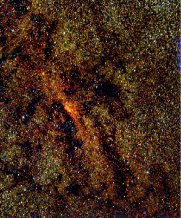Galactic Centre Infrared Surveys
IRAS follow-ups
IRAS sources within 15 arcmin of the galactic centre were searched for in
the L-band, leading to the identification of a number of interesting very
red objects including what is now known as the Quintuplet cluster, a
recently formed cluster that contains many massive stars. It contains some
stars very similar to those in the cluster at the galactic centre.
(MNRAS, 234, 115, 1988).
(see also "Quintuplet" Cluster).
Following work by Feast in which many IRAS sources in the Baade's Window
clear field close to the Centre were identified with known long-period
variables, a search was made for the counterparts of the remaining
unidentified sources (MNRAS, 221, 879, 1986). All but one were
found to be Mira-like variables and were subsequently followed up in order
to determine their periods.
(see also Baade's Window Fields in the Bulge).
2 x 1 Sq Degree JHK Survey
Dating from before the advent of infrared detector arrays, this
collaborative project with R.M. Catchpole and P.A. Whitelock involved 477
drift scans, each lasting 10 minutes, with the 1.9m telescope. The necessary
observations stretched over three observing seasons. A special photometer
was constructed with three side-by-side apertures 6 x 12 arcsec, one each
for J, H and K. The coverage was approximately 2 x 1 sq degrees (RA x Dec),
centred about 0.5 degree E of the Galactic Centre. Quantitative photometry
was extracted and used to trace the stellar density as a function of
galactocentric distance. Shadows caused by the cores of dense molecular
clouds in the foreground correlate well with low-velocity 13CO maps
(MNRAS, 227, 373, 1987; 247, 479, 1990).
|

|
Composite image of the Galactic Centre, from the work of Glass, Catchpole
and Whitelock (MNRAS, 227, 373, 1987; image prepared by R.M.
Catchpole). Here, J is coded as blue, H as green and K as red. The original
black and white images covered about 1.8 x 1.1 degrees; this one covers
about 0.9 by 1.1 degrees. Note the very dense dark clouds which stop even K
light (2.2 microns wavelength) from getting through, implying that they are
associated with visual extinction of 60 magnitudes or more.
|
Galactic Centre Variable Star Survey
Using the PANIC camera on the 0.75-m telescope at Sutherland, a 24 x 24
arcmin square, centred on the Galactic Centre, has been surveyed on numerous
occasions over 4 years, mainly in the K-band. Collaborators in this project
were S. Matsumoto, B.S. Carter and K. Sekiguchi. The results were reported
in MNRAS (321, 77, 2001). A total of 409 likely long-period
variables were detected, for which positions, amplitudes, average mags and
periods were obtained whenever possible. The surface density of LPVs is more
than ten times greater than in the Sgr I Baade's Window.
The limits of completeness arising from interstellar and circumstellar
absorption are discussed. Most of the area suffers visual extinction of
between 20 and 40 mags. The shorter-period LPVs are less luminous than the
longer-period ones and may be slightly under-represented in the data.
Almost all of the LPVs are Miras or OH/IR stars. K-band counterparts have
been found for 59% of the 109 known OH/IR stars in the field. The average
period of the variables found is 427 days, while that of the OH/IR stars is
524 days. The average period in the SgrI window, which contains no known
OH/IR stars, is 333 days. The survey field also contains a number of
long-period, large-amplitude variables which are not OH emitters.
A more recent survey of this kind but deeper and better was reported by
Matsunaga, Kawadu, Nishiyama, Hatano, Tamura, Glass and Nagata (MNRAS
399, 1709, 2009).
ISOGAL Survey
As an associate member of this collaboration, which makes use of the ISOCAM
camera on the ISO satellite to survey many areas at 7 and 15 microns along
the galactic plane and inside the Bulge, I have been particularly interested
in the Baade's Window fields. They represent an ideal comparison area for
the more heavily obscured fields, since much is known about their contents
already.
Most of the objects found in the survey are late-type M-giants, including
Miras and semi-regular variables. In the ISOGAL colour-magnitude [7] - [15]
vs [15] diagram there is a clear sequence of increasing dust shells with
cooler spectral types. The dust shells of some of the non-Mira M-stars are
just as luminous as the shorter-period Miras. There is a tight
colour-period relation (Glass, Ganesh, Alard, Blommaert, Gilmore, Omont,
Schultheis, Simon, MNRAS, 308, 127, 1999).
Return to start
